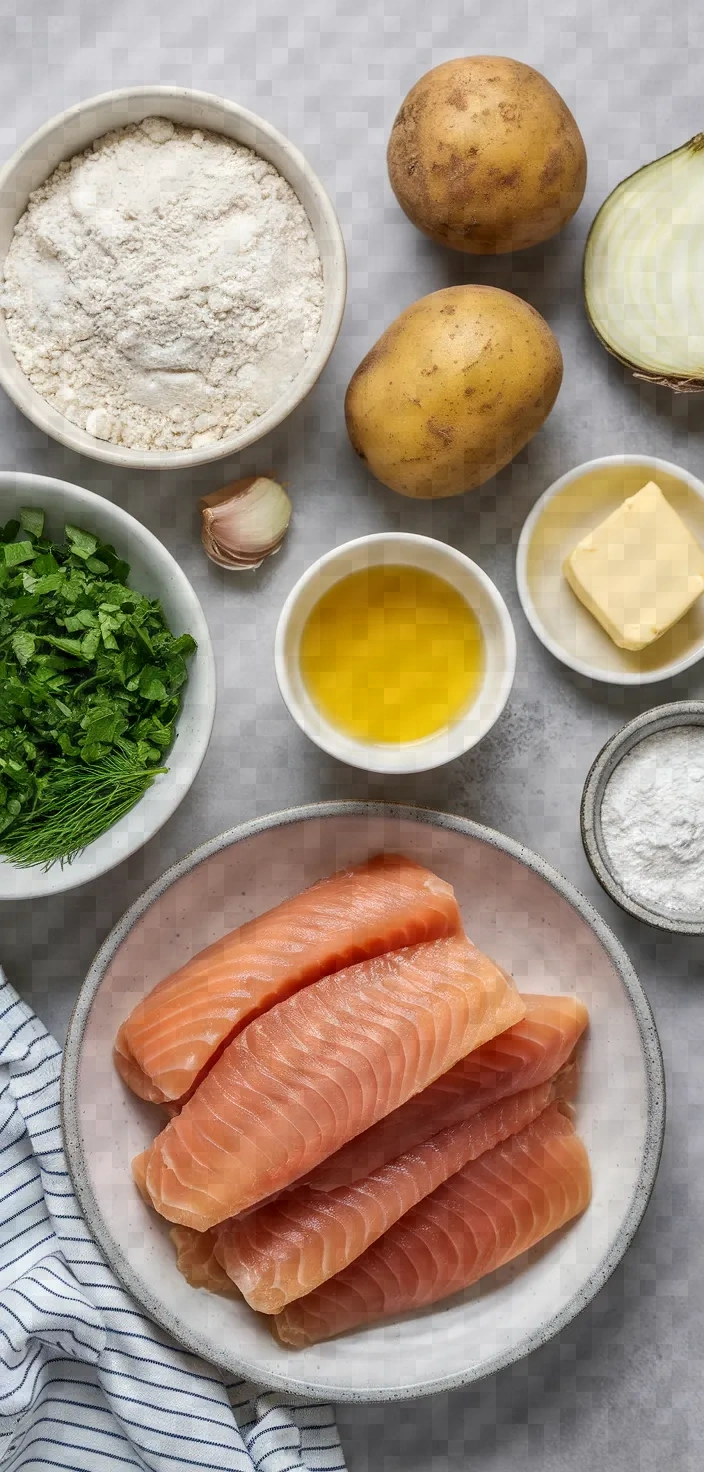Fish cakes are a delightful way to enjoy the nutritional benefits of fish in a dish that’s both delicious and satisfying. I love using fresh fish fillets, like cod or tilapia, which provide essential omega-3 fatty acids that are known for supporting heart health.
I combine the fish with a starchy component—diced potatoes—that brings a balance of complex carbohydrates into the mix, yielding a cake that is more filling than a serving of fish alone. Finely chopped onion and minced garlic take the flavor and health benefits of the dish up a notch, delivering a tarnish of tasty antioxidants across your palate.
I believe that fresh parsley is a great herb to use in this dish; it adds a burst of freshness and plenty of vitamin K. Dill can also be used; its unique fragrance and flavor can give the cakes a depth that I quite like.
Binding the mixture together is easy with a beaten egg, which ensures the cakes hold together while frying. A splash of lemon juice gives the mixture a nice, zesty lift, and, again, provides some extra vitamin C.
Once formed, the fish cakes are coated very lightly in all-purpose flour, which allows them to get nice and crispy when fried in a combination of vegetable oil and butter. After that, it’s just salt and pepper to taste, and you’ve got a delicious, nutritious fish cake.

Ingredients

Fillets of Fish: Packed with protein and omega-3 fatty acids, promotes cardiovascular wellbeing.
The following items make different contributions to a recipe.
Potato: Contributes carbohydrates for energy, contributes a creamy texture.
Onion: Imparts taste and natural sweetness; antioxidant powerhouse.
Enhancing taste and delivering anti-inflammatory advantages, garlic is a true functional food.
Parsley: This herb is fresh and packed with vitamins A and C.
It adds a brightness and freshness that is incomparable.
Juice from Lemons: Imparts a tangy taste, is abundant in vitamin C, and greatly enhances flavor.
Ingredient Quantities
- 1 lb fresh fish fillets (such as cod or tilapia), skin removed
- 1 large potato, peeled and diced
- 1 onion, finely chopped
- 2 garlic cloves, minced
- 1 tablespoon fresh parsley, chopped
- 1 tablespoon fresh dill, chopped (optional)
- 1 egg, beaten
- 1 tablespoon lemon juice
- Salt and pepper to taste
- 1/2 cup all-purpose flour (for coating)
- 1/4 cup vegetable oil (for frying)
- 1 tablespoon butter (for frying)
Instructions
1. In a pot of salted water, boil the potato, cut into small dice, until tender, which takes about 10 minutes. Drain and mash the potato; set aside. Let the potato cool down.
2. In a large frying pan, place the fish fillets, and add enough water to cover. Sprinkle in a pinch of salt. Bring to a simmer and poach the fish for about 5 minutes, until it’s cooked through. Remove the fish from the pan and allow it to cool slightly. Then, flake the fillets into a large bowl.
3. In another skillet, pour a small amount of oil and sauté the chopped onion and minced garlic until soft and see-through, about 5 minutes. Let it cool.
4. In a large mixing bowl, combine the following ingredients: the mashed potato, the flaked fish, the sautéed onion and garlic. Add the chopped parsley, chopped dill (if using), beaten egg, lemon juice, salt, and pepper. Mix well until all ingredients are fully incorporated.
5. Form the mixture into patties, using approximately 1/4 cup of mixture per patty. The number of patties you yield should be around 8-
10.
6. Put the flour on a plate and lightly coat each fish cake with it, shaking off any excess.
7. In a sizable frying pan, warm the vegetable oil and butter over a medium flame until they are hot.
8. In batches, fry the fish cakes, making sure not to overpopulate the pan. Each side of the cakes should get about 3-4 minutes on the heat until they’re golden brown and thoroughly warmed.
9. Take the fish cakes out of the pan and let them drain on paper towels to get rid of any extra oil.
10. Serve the fish cakes warm, with extra lemon wedges or fresh herbs for garnish, if you’d like. You can enjoy them as a plate of your own or as part of the shared seafood platter.
Equipment Needed
1. Large pot
2. Chef’s knife
3. Cutting board
4. Potato masher or fork
5. Slotted spoon or regular spoon
6. Large frying pan (for poaching and frying)
7. Medium skillet (for sautéing)
8. Wooden spoon or spatula
9. Large mixing bowl
10. Measuring spoons
11. Plate (for coating fish cakes)
12. Paper towels
FAQ
- Q: Can I use frozen fish fillets instead of fresh?A: Yes, frozen fish fillets are fine to use. Just be sure, when you are using, to thaw completely and dry well to get rid of any extra moisture.
- Q: What can I use instead of potato if I want a low-carb option?You can replace the potato with cauliflower to maintain a low-carb recipe.
- Q: How can I make these fish cakes gluten-free?To coat the fish cakes, use an all-purpose gluten-free flour or almond flour.
- Q: Can these fish cakes be baked instead of fried?Q: How do I get perfect gyoza?
A: Yes, bake them in a preheated oven at 400°F (200°C) for about 20 minutes or until golden brown, flipping halfway through.
- Q: How do I store leftover fish cakes?B: Keep any uneaten fish cakes in an airtight container in the fridge for up to three days. When you’re ready to eat them, reheat them in a pan or oven and serve.
- Q: What dipping sauce pairs well with fish cakes?A: Excellent choices include tartar sauce, aioli, or a simple yogurt and dill sauce.
Substitutions and Variations
Canned tuna or salmon may be used as a substitute when fresh fish fillets are not available.
Substitute with sweet potato or parsnip for a different flavor.
Shallots may be used as a substitute for onions when a milder taste is desired. Scallions can be used for an even lighter flavor.
Fresh parsley: Replace with fresh cilantro or basil for a twist in taste.
Panko breadcrumbs or almond flour can serve as substitutes for flour, with the former being a suitable option for those who require a gluten-free diet.










